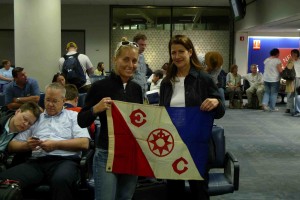Â
On this final day of sampling, we found ourselves back up north…farther north than before. It seems that every day we steam north to start the sampling. The reason for this is to keep up with the migration of the salmon post-smolts. They are funneling along the shelf here off of the Voering Plateau moving with the northerly current.Â
With the anticipation of heading back to port, everyone was excited to have a great day here on the calm Norwegian Sea. With the net in the water, the sun came in and out most of the day and finally stuck around for the entire haul of the last tow. With the sun shining, the birds were soaring around the ship and the final haul came in yielding a fair number of post-smolts along with an escaped hatchery fish. This adult fish was in very good condition but had been eating seaweed because it looks like fish pellets. This is not a nutritious substitute for the small fish and plankton the fish should be eating.Â
Â
An adult salmon from the trawl.
We are now steaming back to Killybegs from above the Arctic Circle. It should be a two and half day steam. Hopefully the seas will stay calm.
The evening brought a beautiful sunset as we passed below the Arctic Circle. The sun disappeared behind a bank of fog before we could see it skim across the horizon as it would up here, but it was a stellar evening nonetheless. Â
Â
Â
Â





